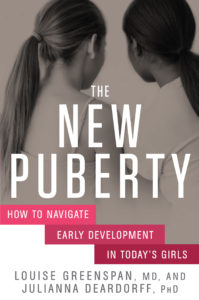 Now and then, I interview individuals who are doing something interesting, inspiring, and entrepreneurial – whether they are pursuing a particular interest, starting a non-profit or business venture, or somehow paved their own way to personal success and happiness. We can all learn from one another on how to better become leaders in our own lives, and I hope you find these conversations as inspirational as I do… for this week, I did a Q&A with Louise Greenspan and Julianna Deardorff, the two Bay Area-based authors of ‘The New Puberty,’ which looks at how puberty is changing for so many young women today.
Now and then, I interview individuals who are doing something interesting, inspiring, and entrepreneurial – whether they are pursuing a particular interest, starting a non-profit or business venture, or somehow paved their own way to personal success and happiness. We can all learn from one another on how to better become leaders in our own lives, and I hope you find these conversations as inspirational as I do… for this week, I did a Q&A with Louise Greenspan and Julianna Deardorff, the two Bay Area-based authors of ‘The New Puberty,’ which looks at how puberty is changing for so many young women today.
1. First and foremost, I was SO excited to see how your book takes a thoughtful, in-depth look at a topic I have been dealing with in my office for years (and talk about extensively in The Myth of the Perfect Girl). Was there one specific moment where either (or both) of you decided “The New Puberty” was a book that needed to be written?
We were often asked to speak to many groups, including Girl Scout troops, parent-teacher associations, moms’ groups, and at elementary schools. It finally got to the point where we couldn’t meet all the requests while
working and taking care of our own children. The logical way to reach more people, who clearly had so many questions, was to put everything we knew from the scientific research, as well as our professional experience, into a book.
2. In the book, you both mention how emotional stressors in a girl’s home and family life can often impact the onset of puberty, and that these emotional impacts are often under examined. Can you give me an example of something you’ve seen in your practice? Is there a way parents can be more aware in preventing emotional stressors from playing such a remarkable role in early development?
Home environments that are emotionally unstable, inconsistent, and dangerous – and those that lack warmth and are high in conflict – appear to negatively influence the timing of girls’ puberty. We know this from the scientific literature. In terms of our practices, though, we regularly urge parents of pre-pubertal girls to be involved in their kids’ lives in an emotionally connected and supportive way. Consistency in parenting is key, as well as safety. These are some of the most important characteristics that make parents the “psychological nutrients” in their kids’ lives.
3. In researching for the book, what was the most surprising research or statistic you uncovered?
We knew this, but it comes as a surprise to many people that girls are showing signs of puberty (meaning breast development or pubic hair) as young as age 7.
 4. In The Myth of the Perfect Girl, I discuss how the social effects of early puberty don’t just affect the girl who has developed early, rather, it can change the entire dynamic within a classroom or friend group, as other girls who may not begin puberty as early may change their behavior in order to appear older. What are the major social issues you see in your respective practices?
4. In The Myth of the Perfect Girl, I discuss how the social effects of early puberty don’t just affect the girl who has developed early, rather, it can change the entire dynamic within a classroom or friend group, as other girls who may not begin puberty as early may change their behavior in order to appear older. What are the major social issues you see in your respective practices?
The data that concerns us the most are the striking statistics about how much earlier African American and Latina girls are entering puberty than girls who are of European /Caucasian or Asian descent. It’s really shocking. Up until now, it’s been commonly believed that these differences are driven solely by race, when in actuality, there might be a number of factors (environmental, nutritional, social) pushing puberty early in certain subgroups, and many of the culprits we identify in our book are certainly more predominant in communities of color or disadvantaged neighborhoods. Also, race/ethnicity may interact with particular exposures, but we know very little about potentially complex relationships between these factors. This demands more investigation.
5. Given that our young people spend so much time at school, what are some things school administrators and teachers should be aware of in terms of the effects of the New Puberty? I often talk about how some elementary school bathrooms don’t have sanitary receptacles even though some girls may be menstruating. Any other suggestions?
One thing is to make sure that schools are teaching all the kids, not just the girls, about what puberty is BEFORE it starts. So this probably means doing puberty education in fourth grade. Some schools do this already, but many wait till the end of fifth grade. This is not sex ed per se, but more like Health Ed about what happens within their bodies. Third and fourth grade teachers need to be prepared for these girls.
6. In Cinderella Ate My Daughter, author Peggy Orenstein discusses the hypersexualized childhood, where five-year-olds are getting manicures and ten-year-olds are wearing sweatpants with “JUICY” emblazoned on their backside. What can parents do to delineate what is appropriate, and what is not age-appropriate?
These decisions are very personal and vary widely from family to family. It’s hard to know where to draw the line, and sometimes there are cultural and regional differences. I don’t think we should preach to everyone what their daughter’s dress code should be. But you should stay true to yourself as a parent, and stick to what feels right to you. In our opinion, (young?) girls don’t need manicures. The chemical exposure is a concern for one thing. But if a mom really wants to bond with their daughter at the spa, then that’s a personal choice and might work for that family. For a five year old, there’s a host of more kid-appropriate activities to choose from!
7. I thought it was incredibly interesting that antibiotics are often under-addressed as influential in acting like hormones in the body. What would be an example of this, and how can a parent whose child has taken a great deal of antibiotics address this issue?
If the antibiotics are for legitimate medical reasons, then it’s important to follow medical advice. And almost all physicians are trying to use antibiotics less now. Of greater concern is the overuse of antibiotics in our food supply; this leads to more antibiotic resistance and other trouble than medical use. So we advise avoiding antibiotic treated food when possible.
8. I love that your book is both reassuring and empowering, and that it doesn’t incite fear. In fact, I enjoyed many of the stories and real-life examples. If you want parents and educators to come away with one major take-away from all your research, what would that be?
For young (pre-adolescent) girls, parents still have a lot of control and can provide a sense of safety and a sound knowledge base for their developing daughters. Arming oneself with knowledge about the pubertal process and opening the doors of communication early between a parent and a child are critical, empowering steps towards protecting our daughters and helping them maximize this transition to adolescence. That was the main reason we wrote this book: to arm parents and caretakers with this information.


Hello,
I have so enjoyed reading this interview and am the mother of 3 young boys. I often feel that boys are left out of the discussion around puberty and appearing older because of their gender. Certainly, I am looking for resources about how to talk to my sons about puberty, their bodies and treating themselves, peers and females respectively, while watching mainstream television.
At times I feel sad because boys have lacked spotlight for sometime. I think their is immense pressure and it is unorganized pressure but certainly palpable to them. For example, they may feel pressure around being the fastest runner, the best baseball hitter and getting good grades and helping “take care”of the home while Dad is at work. We need to shift our focus to humanness and take gender out of the equation. Raising young ones and little ones is like being a fish out of water… Any stories, advise, wisdom shared is much appreciated.
I thank you in advance,
Heather